

Moulage sous vide composites : montage de polymérisation sous vide. Fiberline Design Manual. Calculateur - SAERTEX Non Crimp Fabrics appelés sur mesure en verre, en carbone et en aramide. The Weaves of Composite Fabrics — Fibre Glast Blog. When talking about composites, it is important to remember that the material you are working with is fiber dominant.
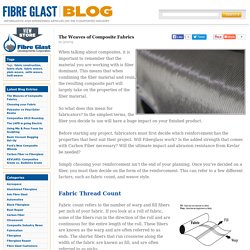
This means that when combining the fiber material and resin, the resulting composite part will largely take on the properties of the fiber material. So what does this mean for fabricators? In the simplest terms, the fiber you decide to use will have a huge impact on your finished product. Before starting any project, fabricators must first decide which reinforcement has the properties that best suit their project. Will Fiberglass work? Simply choosing your reinforcement isn’t the end of your planning. Materialrechner – en. Vacuum Bagging: Basics - Composite Materials. Vacuum Bagging: Basics Laminate Quality When manufacturing a traditional metal structure, you start with the material in its final form.
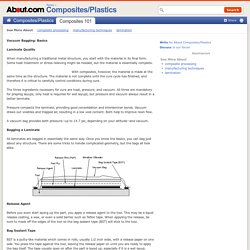
Some heat treatment or stress relieving might be needed, but the material is essentially complete. With composites, however, the material is made at the same time as the structure. The material is not complete until the cure cycle has finished, and therefore it is critical to carefully control conditions during cure. The three ingredients necessary for cure are heat, pressure, and vacuum. Pressure compacts the laminate, providing good consolidation and interlaminar bonds. A vacuum bag provides both pressure--up to 14.7 psi, depending on your altitude--and vacuum.
Understanding The Filament Winding Machine. Filament winding machines are used to create a wide range of products such as cylinders, pipes, pipe joints, storage tanks, drive shafts, masts and pressure vessels.
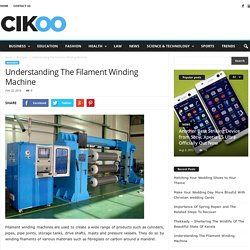
They do so by winding filaments of various materials such as fibreglass or carbon around a mandrel. How Do They Work? The idea behind these machines is a very simple one. Centro Español de Plásticos. Building With Chemistry. Listings Archive - Composite à matrice céramique - CMC - Matériau composite à matrice céramique. Composite Materials Industry Terms. Accelerator – A catalyst added to a polyester resin to speed up curing polyester resin at room temperature.
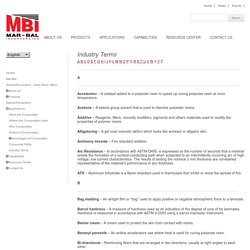
Acetone – A ketone group solvent that is used to dissolve polyester resins. Additive – Reagents, fillers, viscosity modifiers, pigments and others materials used to modify the properties of polymer resins. Alligatoring – A gel coat cosmetic defect which looks like wrinkled or alligator skin. Antimony trioxide – Fire retardant additive. Composite materials – is the use of proper definitions important? Choosing your Composite Fabric - Fiber Glast Blog — Fibre Glast Blog. Basics of Vacuum Bagging Set Up - Fibre Glast Blog — Fibre Glast Blog. Vacuuming bagging is a technique used to create mechanical pressure on a laminate during its curing cycle.
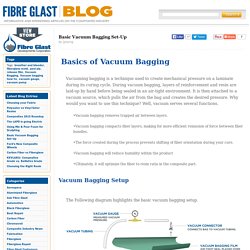
During vacuum bagging, layers of reinforcement and resin are laid-up by hand before being sealed in an air-tight environment. It is then attached to a vacuum source, which pulls the air from the bag and creates the desired pressure. Glossary of Terms. There are many terms used in the composites industry.
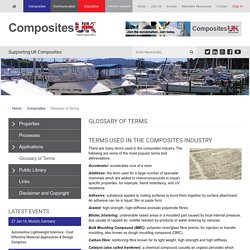
The following are some of the more popular terms and abbreviations. Accelerator: accelerates cure of a resin Additives: the term used for a large number of specialist chemicals which are added to resins/compounds to impart specific properties, for example, flame retardancy, and UV resistance Adhesive: substance applied to mating surfaces to bond them together by surface attachment. An adhesive can be in liquid, film or paste form.
The Mechanical Engineering Blog — Delamination in a Composite Bend. It’s warm within: Autodesk and RocTool achieve simulation of induction heating within the mold. Reinforcements - Composite Materials. Variable stiffness composites. In previous posts I have discussed the unique characteristics and manufacturing processes of a certain type of composite material, namely continuous fibre-reinforced plastics (FRPs).

Just like many other composite materials, FRPs combine two or more materials whose combined properties are superior (in a practical engineering sense) to the properties of the constituent materials on their own. What distinguishes FRPs from other composites such as short-fibre composites, nanocomposites or discrete particle composites are the highly aligned, long bundles of fibres typically glass or carbon that are arranged in a specific direction within some resin system. The biggest advantage of FRPs compared to metals is not necessarily their greater specific strength and stiffness (i.e. strength/density and stiffness/density) but the increased design freedom to tailor the structural behaviour. Sandia Energy – Online Abstracts and Reports. Composites HUB. La fabrication du plastique en 5 étapes. Le naphta, ingrédient de base du plastique Le naphta est un liquide issu du raffinage du pétrole qui se condense entre 40 et 180 °C.

Il constitue la matière première des plastiques. Avant d’être utilisé par les plasturgistes, le naphta doit subir une opération de craquage. Le craquage Sous l’effet d’un chauffage (800 °C) puis d’un refroidissement brutal (400 °C), les grosses molécules d’hydrocarbures qui constituent le naphta se voient fragmentées en molécules plus facilement exploitables. La polymérisation Les monomères obtenus après craquage contiennent entre 2 et 7 atomes de carbone chacun. La mise en forme À la sortie de la raffinerie, les polymères se présentent sous forme de granulés, de liquides ou de poudres. Le recyclage des déchets plastiques Après usage et collecte, les déchets plastiques sont acheminés vers des usines de traitement pour y être prélavés et triés. Il est à noter que le pouvoir calorifique du plastique équivaut à celui du charbon ou du pétrole.
Sur le même sujet. How to Handle CNTs Safely in the Lab. Download as PDF.
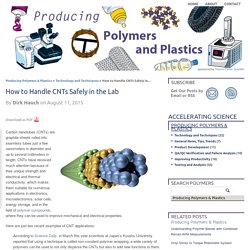
Imetrum launches ‘3D Precision Displacement Tracker (PDT) at the Composites Engineering Show 2015. 3D measurements come alive at Composites Engineering 2015 as Imetrum launch the new ‘3D Precision Displacement Tracker (PDT)’ the world’s highest precision camera based 3D measurement system.

Posted via Industry Today. Follow us on Twitter @IndustryToday Bristol, UK, October 6, 2015: This year at the Composites Engineering Show, non-contact precision measurement specialists Imetrum will be demonstrating its precision 3D measurement capability live throughout the show on Stand F111. Imetrum’s 3D PDT slashes setup times and provides richer data sets, without compromising measurement resolution or sampling speed. 787 Dreamliner. Airbus, a leading aircraft manufacturer. ATL and AFP: Defining the megatrends in composite aerostructures. For most of its history, most of the aerospace industry has taken advantage of carbon-fiber-reinforced composites at great expense: Individually cut prepreg are painstakingly hand layed by highly trained technicians, the best of whom can place about 2.5 lb of material per hour.
Only 10 years ago, if a knowledgeable composite aerostructure pro like Spirit AeroSystems Inc.’s (Wichita, Kan.) Terry George (then a Boeing Commercial Airplanes employee) had been told that within a decade, he’d be building the massive nose and front fuselage barrel section of a new all-composite wide-body commercial aircraft fuselage from carbon-fiber reinforced epoxy, the idea of doing so with the prevailing manual technology would have seemed a practical and financial impossibility. “Ten years ago, I would never have believed we would be building a composite airplane,” says George. AFP/ATL fundamentals and evolution. A la découverte des matériaux d'impression 3D - Première partie : Les plastiques. Pour fabriquer un objet, on doit connaître les matériaux qui le composent… 3Dnatives ne vous explique pas seulement les différentes techniques d’impression 3D, mais également les matériaux qui sont au coeur de cette technologie : les plastiques, les métaux, les matériaux organiques et les céramiques.
On s’attaque aujourd’hui aux matériaux les plus usités en impression 3D – les plastiques. C’est le matériau phare des briques de Lego, très utilisé aussi dans la carrosserie des voitures, les appareils électroménagers et dans de nombreuses applications de capotage. Il appartient à la famille des thermoplastiques mais contient une base d’élastomère à base de polybutadiène qui le rend souple et résistant aux chocs.
L’ABS (acrylonitrile butadiène styrène) fond entre 200 et 250 ºC et peut supporter des températures très basses (- 20 ºC) comme élevées (80 ºC). Carbon Fiber - A Lesson in Composites. Ah, carbon fiber, that silky black fabric. Rolling over complex and compound surfaces this seductive material is the object of many a gearhead’s race car fetish. Carbon fiber is not just bling to be simulated in vinyl wraps, or textured ABS plastic parts, it is an advanced material with specific properties, applications, drawbacks, and features.
The rhetoric of carbon fiber is one of weight savings, strength, stiffness, and aesthetics. While all these factors have their place there are many misconceptions about this velvety, elemental material. Advanced Composites Market by Type, by Manufacturing Process, by Resin Type, by Application, and by Region Global Forecast to 2020. LONDON, Sept. 23, 2015 /satPRnews.com/ — The advanced composites market size of end products in terms of value was $16.3 billion in 2014 and expected to grow at a CAGR of 7.2% between 2015 and 2020. North America held the largest share by volume in advanced composites market in 2014. Major growth in the North America region is expected from the growing aerospace & Defense application industry. The advanced composites market in Asia-Pacific region is growing fast as the application industries such as sporting goods, automotive, construction, aerospace and wind industry are expected to register a significant growth rate in next five years.
Presence of emerging economies such as India and China are helping the advanced composite market to grow in the region. The freeing up and privatization of the industry, and massive foreign investment combined with low costs are factors in this growth. The Micromechanics Approach and Multiscale Modeling of Composites - Altair Innovation Intelligence. Material modeling remains one of the interesting challenges in composites design. Composite Materials. Outils composites - Dossier spécial : Outils composites. Mécanique & Composites.